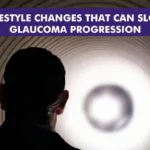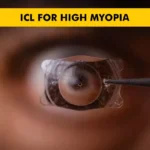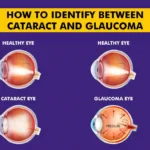Cataracts are a leading cause of vision loss worldwide, affecting millions of people each year. They occur when the natural lens of the eye becomes clouded, leading to impaired vision. While aging is a well-known risk factor, many people wonder if cataracts can be hereditary.
In this blog post, we will explore what cataracts are, their symptoms, causes, and risk factors, and delve into the genetic aspects of cataract development. Understanding these factors is crucial for early detection and effective management of cataracts.
What Are Cataracts?
Cataracts refer to the clouding of the eye’s natural lens, which lies behind the iris and the pupil. The lens works like a camera lens, focusing light onto the retina at the back of the eye. It also adjusts the eye’s focus, enabling us to see things clearly both up close and far away.
When the lens becomes cloudy, it prevents light from passing through properly, causing blurred or dim vision. Cataracts can form in one or both eyes and do not spread from one eye to the other.
Symptoms, Causes, and Risk Factors of Cataracts
Symptoms of Cataracts:
- Blurred Vision: A common early sign where objects appear out of focus, making it difficult to see clearly.
- Difficulty Seeing at Night: Reduced ability to see in low-light conditions, often making night driving challenging.
- Sensitivity to Light: Increased discomfort or pain from bright lights, which can cause squinting or the need to wear sunglasses indoors.
- Seeing ‘Halos’ Around Lights: Rings or halos may appear around light sources, particularly noticeable at night.
- Frequent Changes in Eyeglass or Contact Lens Prescriptions: A need for frequent updates to vision correction as cataracts progress.
- Fading or Yellowing of Colors: Colors may appear less vibrant or take on a yellowish tint, affecting color perception.
Causes of Cataracts:
- Aging: The most common cause, as proteins in the lens break down over time, leading to cloudiness.
- Genetic Factors: Inherited genetic mutations can predispose individuals to develop cataracts earlier or more severely.
Risk Factors for Cataracts:
- Diabetes: Increases the risk due to high blood sugar levels affecting the lens.
- Excessive Exposure to Sunlight: UV radiation can damage the proteins in the lens, accelerating cataract formation.
- Smoking: Contributes to oxidative stress and damage to the eye’s lens.
- Obesity: Associated with metabolic changes that can affect eye health.
- High Blood Pressure: Can lead to changes in the eye’s blood vessels, impacting lens health.
- Previous Eye Injuries or Surgeries: Trauma or surgical interventions can increase the risk of cataract development.
- Prolonged Use of Corticosteroid Medications: Long-term use can lead to changes in the lens, promoting cataract formation.
- Excessive Alcohol Consumption: Linked to nutritional deficiencies and oxidative stress, which can affect the lens.
Cataract Development and Progression
Cataracts typically develop at a gradual pace, often going unnoticed in the early stages. This slow progression means that many individuals may not realize they have cataracts until the condition has advanced significantly. Initially, the clouding of the lens may cause only minor vision disturbances, such as slight blurriness or difficulty with glare. However, as the lens continues to cloud over time, these vision problems become more pronounced and can lead to significant challenges in performing daily activities. Tasks that require clear vision, such as reading, driving, or recognizing faces, may become increasingly difficult, impacting one’s quality of life.
The progression of cataracts is not uniform and can vary greatly from one individual to another. In some individuals, cataracts may progress rapidly, leading to a swift decline in vision quality. This rapid progression can necessitate earlier intervention to restore vision. Conversely, in other individuals, cataracts may develop at a much slower rate, remaining stable for many years without causing significant vision impairment. This variability underscores the importance of personalized monitoring and care.
Genetics and Eye Health: An Overview
Genetics plays a significant role in many aspects of eye health, including the development of cataracts. Although aging is widely recognized as the most prevalent cause of cataracts, it is important to note that genetic predisposition can significantly elevate the chances of developing cataracts at a younger age or in more severe forms. This genetic influence is due to specific mutations that can alter the proteins constituting the eye’s lens, ultimately leading to the formation of cataracts. By gaining a thorough understanding of your family history, you can uncover valuable insights into your personal risk factors. This knowledge can empower you to take proactive preventive measures, such as regular eye examinations and lifestyle adjustments, to mitigate the potential impact of cataracts on your vision.
Scientific Studies on Cataracts and Heredity
Numerous scientific studies have explored the hereditary aspects of cataracts. Research has shown that individuals with a family history of cataracts are at a higher risk of developing the condition themselves. Specific genes that are associated with cataract formation have been identified.
For example, mutations in the CRYAA and CRYBB2 genes, which encode for crystallin proteins in the lens, have been linked to congenital cataracts. These findings highlight the importance of genetic factors in cataract development.
Prevention and Early Detection Strategies
While you cannot entirely prevent cataracts, certain lifestyle changes can reduce your risk.
- Wear sunglasses to protect your eyes from UV rays.
- Maintain a healthy diet rich in antioxidants.
- Avoid smoking.
- Manage chronic conditions like diabetes.
- Reduce alcohol consumption.
- Schedule regular eye exams for early detection.
- Prioritize early diagnosis to manage the condition effectively and prevent severe vision impairment.
Conclusion
Cataracts are a common eye condition that can significantly impact vision and quality of life. While aging is the primary risk factor, genetics also play a crucial role in the development of cataracts.
Understanding the hereditary aspects of cataracts can aid in early detection and better management. By adopting preventive measures and undergoing regular eye check-ups, you can protect your vision and maintain eye health.
FAQs
Yes, genetics can play a role in cataract development, but they are also influenced by age and environmental factors.
Blurry vision, difficulty with night vision, and increased sensitivity to glare are common early signs.
While you can’t prevent age-related cataracts entirely, wearing UV-protective sunglasses, maintaining a healthy diet, and avoiding smoking can help reduce risk.
Cataract surgery is one of the safest and most effective surgeries, with a high success rate.
Yes, congenital cataracts can occur in children, often due to genetic factors or other underlying conditions.





